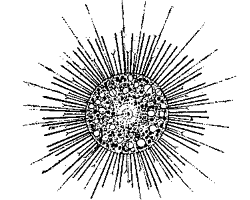







Despite the large body of research surrounding these organisms, the classification of the Radiolaria has proven to be very difficult. The species that make up the Radiolaria have numerous unique characteristics, and yet this has has not helped to elucidate a definite scheme to classify these organisms. What is known for certain is that the Radiolaria are a diverse group of unicellular protists with a number of unique and unusual characters.
Historically speaking, there has been little agreement among taxonomists on how to classify individual Radiolaria. It has been stated that "no single integrated body of information drawing upon the cognate disciplines of micropaleontology, reproductive biology, genetics, ecology, and molecular and cellular biology is of sufficient magnitude to serve as a paradigm for development of a clearly natural classification scheme" (Anderson p. 82). In 1887, Ernst Haeckel proposed one of the earliest classification schemes in which he divided Radiolaria into four major called legions (taxa): (1) Spumellaria, (2) Nassellaria, (3) Phaeodaria, and (4) Acantharia. However, due to the discovery of many new species, and discoveries regarding the morphology of the Heliozoa, Haeckel's classic scheme is no longer deemed acceptable.
 The current methods for classification are based largely on the study of
skeletons from the orders Spumellaria and Nassellaria. The skeleton of order
the other groups. Since Haeckel, there have been various taxonomic schemes
proposed, such as that by Reidel in 1967 which placed the group as follows:
Kingdom Protista, Phylum Sarcomastigophora, Subphylum
Sarcodina, Class Actinopoda, Subclass Radiolaria,
Superorder Polycystina, Orders Spumellaria / Nassellaria /
Phaeodaria. In this taxonomic scheme, Radiolaria are assigned to Actinopoda
along with the Heliozoa (sun animals) and Acantharia because of their delicate
pseudopodial network.
The current methods for classification are based largely on the study of
skeletons from the orders Spumellaria and Nassellaria. The skeleton of order
the other groups. Since Haeckel, there have been various taxonomic schemes
proposed, such as that by Reidel in 1967 which placed the group as follows:
Kingdom Protista, Phylum Sarcomastigophora, Subphylum
Sarcodina, Class Actinopoda, Subclass Radiolaria,
Superorder Polycystina, Orders Spumellaria / Nassellaria /
Phaeodaria. In this taxonomic scheme, Radiolaria are assigned to Actinopoda
along with the Heliozoa (sun animals) and Acantharia because of their delicate
pseudopodial network.
In 1980 Levine proposed another scheme: Kingdom Protista, Phylum Sarcomastigophora, Subphylum Sarcodina, Superclass Actinopoda, Class Radiolaria. In this scheme, Radiolaria is not considered a natural group, and Spumellaria, Nassellaria, and Phaeodaria are considered to be subclasses. These are just two possible classifications that have been proposed for Radiolaria.
More recent work has focussed less on the hierarchy of names, and more on determining the evolutionary relationships among the Radiolaria with molecular data. Molecular and morphological evidence suggest a close relationship with the Heliozoa (such as Actinophrys, pictured at right) and perhaps the Acantharia (a small group of protists with skeletons of strontium sulfate). These three together may be closely related to another large group of protists known collectively as the alveolates.
Since it has been stated that it is difficult to successfully and completely classify Radiolaria, we must ask ourselves what additional information is need to construct a complete taxonomic scheme. O. R. Anderson (1983) proposed that additional information is need in 5 major areas. He proposes that there be more research in the following five areas:
Clearly, a taxonomic classification is no small matter. Though some of the data needed to successfully complete the classification are present, some vital information is still lacking. In general, very little is known about the Radiolaria. Ultimately, it will simply be a matter of time as more research is done and before a complete and agreed upon taxonomic classification is made.


